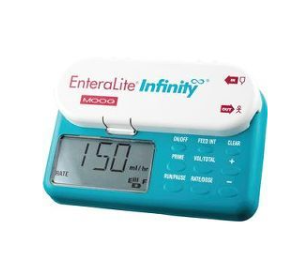
Entera LiteInfinity® Feeding pump
A nutrition delivery system for living. It’s a versatile enteral feeding system that has been designed to go wherever patients go. Its small size and portability enables patients to adhere to recommended activity prescriptions, and get the nutrition they need for living.
Demonstration Videos
SPECIFICATIONS
Product Specifications
- Manufacturer: Moog
- Weight: 14.4 Ounces (408 g)
- Flow Rate: 0.1 ml/hr from 0.1 – 10 ml/hr from 10 – 600 ml/hr
- Flow Rate Accuracy: +/- 5% of Selected Flow Rate
- Dose Limit: 0.1 ml from 0.1 – 10 ml; 1 ml from 10 – 3000 ml
- Operating Orientation: Any
- Memory: Settings Retained Until Use Changes
- Battery: Lithium Ion; 24 Hours at 125 mL/hour; 6 Hour Recharge Time
- Maintenance: No Annual Maintenance or Calibration Required
- Cleaning: Washable Under Running Water (Water-Resistant)
- Kit Contents: Pump, Charger, Pole Clamp, Operator’s Manual
- Product Number: 90049859
USER MANUAL
FREQUENTLY ASKED QUESTIONS
Helpful Hints
Enteralite Infinity Pump
The Enteralite Infinity enteral feeding pump is light, portable and easy to use. It fits inside an enteral backpack with ease, so that you can go about your daily activities and still get the nutrition your body needs to stay active.
Supplies:
- 60 milliliter catheter tip syringe
- Room-temperature water
- Feeding bag
- Feeding Pump
- IV pole or Backpack
- Formula
Instructions:
- Wash your hands to reduce the risk of bacterial contamination.
- Get your supplies together: formula, 60 milliliter catheter tip syringe, room-temperature water, feeding bags, feeding pump and IV pole or enteral backpack (a pack designed to hold your feeding bag so you can feed on-the-go).
- Check the skin around your feeding tube. If you notice redness, pain, irritation or leaking around the site, notify your doctor or nurse.
- You should be sitting upright for your feeding and for 30 to 60 minutes afterward.
- Check the position of your feeding tube. You should have about the width of a dime between your skin and the external bolster. In most cases, the tube should turn freely.
- Place the tip of the syringe in the water and pull back on the plunger to draw up 30 to 60 milliliters of water (or the amount advised by your healthcare professional).
- If you have a low profile feeding tube, attach the extension tubing.
- Open your feeding port and flush the tube by slowly pushing on the syringe’s plunger. Flushing your tube before and after feedings helps to clear out any formula or medication residual to prevent clogging of your tube. Flush the tube every time you use it for feeding or medications or every time you turn the pump on and off.
- Hang the feeding bag from the IV pole so that the bag is at least 18 inches above you. If you have an enteral backpack, secure the bag inside and thread the tubing through the holes and out the back of the backpack.
- Insert the cassette into the feeding pump. The cassette is the blue loop part of the tubing connected to the feeding bag. The loop wraps around the rotor to push the formula through the tubing and into your body. Close the pump door and turn the pump on. Keep it plugged in if you are near an electrical outlet to keep the pump charged.
- Open the bag and pour in the desired amount of formula.
- Remove the cover on the tip of the feeding bag’s tubing. Position the tip of the tubing over a receptacle to catch any formula that drips out.
- Prime the tubing to release any air. This will prevent the air from going into your body and making you uncomfortable. You can do this manually or with the automatic prime feature of the pump. Manual priming may be faster.
- To prime the tubing manually, squeeze any air out of the bag and close it. Remove the cassette from the pump. Look for a raised tear-drop etched onto the blue part of the tubing. Gently press the tubing together with your thumb and index finger to allow the formula to free-flow through the tubing until it reaches the tip. Re-insert the cassette into the pump and close the door.
- To prime the pump using the prime feature, push and hold the prime button until the formula reaches the end of the tubing. Release the prime button.
- Attach the tip of the bag’s tubing to your feeding tube or extension tubing.
- Set the rate of the pump by pressing the “rate/dose” button until the word “RATE” is displayed on the screen. Push the “+” button until the desired rate is reached.
- Set the dose you want to deliver by pressing the “rate/dose” button until the word “DOSE” is displayed on the screen. If you want to set a specific amount, push the “+” button until the desired amount is reached. If you want the pump to simply shut off when the formula is gone, continue to push the “+” button until the “INF” (Infinity) is displayed on the screen.
- If you experience any symptoms of feeding intolerance, such as nausea or vomiting, diarrhea or abdominal bloating, contact your healthcare professional.
- When you are done feeding, disconnect the bag tubing from your feeding tube.
- Flush your feeding tube with water as above with the amount recommended by your healthcare professional.
- Close the feeding port and disconnect the extension tubing if applicable.
- Refrigerate any leftover formula for use within 24 hours.
- Wash and dry all equipment and your hands. Use a new syringe and feeding bag each day.
RELATED ITEMS
PEG Tube – Enteral Feeding Instructions
What is a PEG tube? It is Read more...
Gastrostomy Tube Instructions
Gastrostomy Tube Enteral Feeding Enteral Nutrition (EN), Read more...
Kangaroo Joey Pump Setup – Enteral Feeding
Kangaroo ePump Enteral Feeding Pump The latest Read more...
Kangaroo Joey Enteral Feeding Pump Instructions
Kangaroo™ Joey Enteral Feeding Pump The Covidien Read more...
How to Unclog Your Enteral Feeding Tube Instructions
How to unclog enteral feeding tube Prevent Read more...
Flocare Infinity Enteral Feeding Pump Instructions
Nutricia Flocare® Pumps Flocare® Infinity™ pumps are Read more...
Compat Ella® Enteral Pump Instructions
COMPAT ELLA® Enteral Feeding pump An innovative Read more...
EnteraLite® Infinity Enteral Pump Instructions
Entera LiteInfinity® Feeding pump A nutrition delivery Read more...

